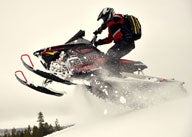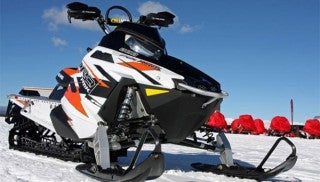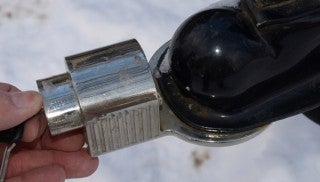2014 Polaris Switchback Assault Review – Video

Pure Crossover Sweetness
In snowmobiling’s history books, Polaris’ Switchback will be known as a trendsetter; the snowmobile voted most likely to succeed as it left its senior year behind.
Many years ago when I first rode a Switchback, Polaris had banked its money on a new mountain line called the RMK – RMK for Rocky Mountain King. Polaris’ previous mountain line, SKS for Snow King Special, became the Switchback.
Following this were years at Polaris where the snowmobile builder defined and redefined the Switchback as a crossover snowmobile. It, like the other OEM crossover snowmobiles, chased market demands or created market demand by being different; the Switchback’s life ebbed and flowed.
Get the Flash Player to see this player. |
Yet, it was the first crossover sled and the one that started the “crossover” niche.
As demand for the Switchback swung up and down, Polaris settled on the Pro Ride chassis – the chassis that makes the Pro Ride RMK Pro so dang popular. This helped turn the Switchback into what I like to call a dual sport crossover snowmobile. Yes, this is redundant, but we journalists at times create phrases that push the obvious.
VIEW: Read our review of the 2013 Polaris 600 Switchback
For this model year, Polaris added the sweet and sassy 600 motor to the Switchback Assault, which I find appealing. For the flatlander, this gives the rider a long track snowmobile that demands less money and less fuel to operate. It is a premium 600 that spares nothing – it is a carbon copy of the 800 Switchback Assault except for motor size.
As Snowmobile.com’s mountain guy, I get just as excited about crossover snowmobiles with deep-powder personalities as I do about mountain snowmobiles.
When the Pro Ride RMK came to be, Polaris shipped one out to me. Alongside the RMK Pro came a “Spring-buy” edition Switchback Assault with the RMK Series 4.0 mountain track. A bond between rider and snowmobile occurred just as tight as the bond between man and his loyal canine.
Enough slobbering.
What is Polaris’ Switchback Assault for season 2014?
The crossover Switchback Assault comes in two variants: 1) Deep-powder and trail, and 2) Powder and trail. Variant number one, deep powder and trail, is the model I am most familiar with. Its track is the 15 x 144 Series 4.0 RMK track with two-inch paddles. This track is the same track the standard RMK 600 144 uses; it is an option only for early Spring-buy purchasers.
Variant two, powder and trail, uses the 15 x 144 Camoplast Cobra track that has a lug height of 1.35-inches.
VIEW: Read our review of the 2013 600 Pro-RMK
For the non-deep powder Switchback Assault, consumers can opt for the 600 or 800 Cleanfire motor. The 600 Switchback Assault can’t be ordered with the Spring-buy Series 4.0 RMK powder track; the 1.35 Cobra track is your only choice.
Both motors are snappy. The Cleanfire fuel injected motor is a proven mill that from my experience delivers reliable power. I am a fan of the 600 motor for it has proven to be the over-achiever. In the RMK Pro 600, I hammer the 600 at wide-open throttle in most conditions. For the Switchback Assault, the 600 delivers sweet power.
For you riders who may trailer from flatland country to the Rockies to ride your 600 Switchback Assault, it’s worth remembering that for every 1000 feet gained in elevation, the Cleanfire motor will lose approximately 3% to 4% of its horsepower due to the thinning air. This is not only for the Cleanfire, but also for any naturally aspirated two- or four-stroke motor.
With that said, the 600 Switchback Assault will perform like a 500 or 440 at higher elevations.
Now for you 800 Switchback Assault riders, your 800 is a fast vehicle in flatland territory. In the Rockies, though, it’ll perform like a zippy 600 or 700, again due to the thin air.
Sea level horsepower for the 600 is approximately 135, whereas the 800 is rated at approximately 155. The 600 and 800 are liquid-cooled engines with semi-direct injection (SDI) that automatically calibrates fuel and timing as temperature and elevations change.
The Assault’s drive train is a chaincase system; the Quick Drive Low Inertia belt drive system is not part of the Switchback Assault’s makeup. No matter, the two-sprocket and chain system is stout and efficient.
The drive clutch is a familiar Polaris P-85. Companion to the drive clutch is Team Industries’ lightweight (LWT) driven. These two clutches work well together. The Team driven has a rapid up and down shift. But, if high mountain riding is in your upcoming winter plans, ensure the correct weights and springs are installed to help the motor dump power to the track as horsepower and torque drops with elevation gains. This is especially important for the 600. Visit with your local dealer.
The Switchback Assault’s rear suspension is the Switchback 144 uncoupled skidframe with tipped up rails. The tipped up rails give the Assault the nimbleness of a 136, yet it maintains good flotation in powder. As we evaluated the two Switchback variants, regardless of motor size, the 1.35-inch Cobra track provided hook-and-go on the trails and delivered the right amount of drift when in a turn’s middle. For you mountain seekers, the Cobra track was not fond of deep powder. On the other hand, the Switchback Assault with the Series 4.0 RMK track was fond of deep snow, but the taller-lugged track did limit the Assault’s speed and corner drift when burning the trails. Decide what you want.
Vertical travel for the 144 rear skid is 15 inches, of which the Assault uses every inch. The front rail shock is a Walker Evans piggyback compression adjustable unit, whereas the rails’ rear shock is a Walker Evans compression-adjustable (non-piggyback) unit.
The Switchback Assault’s front suspension is the Pro-Ride with a fixed ski width of 42.5 inches. The Switchback Assault’s ski is the Pro-Steer, wholly different than the wide and deep-keel Gripper ski used on Polaris’ RMK. Bump soak is handled by Walker Evans piggyback compression-adjustable shocks. Vertical travel is 10 inches.
The cockpit area is Pro Ride, similar to the RMK. Pro Taper handlebars come with end hooks and a lower-than-RMK-Pro riser block. Unlike the RMK, these bars do not have a mountain grab bar – the center pull strap. You will not miss it as the Pro Ride chassis designed for the Switchback Assault is agile and rolls with ease to its right or left.
COMPETITION: Read our review of the 2014 Ski-Doo Freeride
Runningboards on the Switchback Assault are similar to those used on a Rush Switchback – wide and meaty. The Hybrid runningboards, as Polaris calls them, surround any wide boot. Snow escape holes are not as generous as the PowderTrac boards used on the RMK, but this is not an RMK. The Hybrid platforms are part Rush and part RMK. Meaning, these wide platforms have foot stirrups that are designed for sitting or standing. Standard on the Hybrid boards are fishbone tunnel reinforcements.
I like the Hybrid runningboards for this sled’s crossover function. However, if riding an 800 Switchback Assault with Series 4.0 RMK track and stuffing the Switchy Assault into a steep powdery hillside, the wide boards will prevent the chassis from fully engaging the hillside; wide boards push out the tunnel, keeping the track from biting to its fullest intent. Is this a bad thing? No. As I wrote earlier, I take the Switchback Assault with RMK track into RMK territory – I challenge its every nerve beyond its design intent.
The seat on the Switchback Assault is the lightweight Freestyle and is different from the RMK Pro Lite seat in that it is somewhat longer and wider.
Both 800 and 600 Switchback Assault models are comfortable trail sleds that do make good powder sleds. The longer rear suspension provides good control over tight and choppy trails. In a seated position, the Switchback Assault is comfortable, due to in part, to its handlebar height. In boondocking mode, it performs well, but will auger down if the snow is overly deep, more so with the Cobra track than the Series 4.0 RMK track.
The 600cc model, new for 2014, is a lively critter. It is made for thick flatland air. If you are a Rocky Mountain occupant, I recommend the 800 to make up for the horsepower loss due to the thin air.
Switchback snowmobiles are a staple at Polaris, be it in the Rush chassis or the RMK-like Pro Ride chassis; its name is building a strong legacy. Crossover snowmobiles are smart snowmobiles giving owners a 50/50 snowmobile that does its part well across two riding niches.
| 2014 Polaris 800 Switchback Assault 144 Specs | |
| Engine | Polaris Liberty, 795cc two-stroke, liquid-cooled, twin; Cleanfire electronic fuel injection; two-into-one exhaust |
| Horsepower | 150+ |
| Drive | Polaris QuickDrive with P-85 driver and TEAM LWT driven |
| Front Suspension | Pro-Ride RMK adjustable A-arm suspension; Walker Evans gas shocks; 10.0-inches of travel; uses Polaris “Pro-Steer” skis |
| Rear Suspension | Polaris Switchback 144 with tipped rail profile; parallel rail slide with Walker Evans shocks; up to 15.0-inches of travel |
| Length | 126.0 in |
| Width | 48.0 in |
| Height | 48.0 in |
| Ski Stance | 42.5 in |
| Track | 15 x 144 x 1.35 Cobra (Also: 15 x 144 Series 4.0) |
| Features | Standard: Phantom hydraulic brake; ProTaper steering; digital multi-function gauge, electronic reverse Options: 12v-DC outlet, electric start, seat support with luggage, mirrors |
| Weight | 460 (claimed) |
| Fuel Capacity | 11.5 US Gal |
| MSRP | $12,399 |








 Your Privacy Choices
Your Privacy Choices